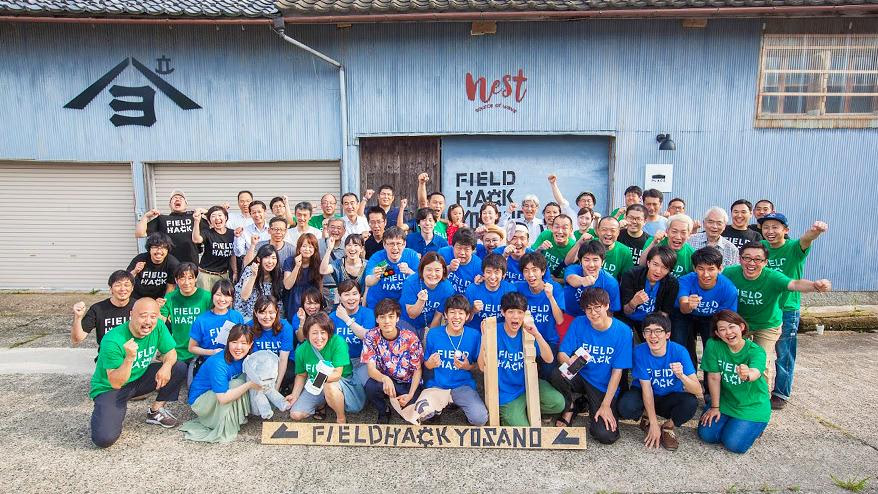みなさんが、可能性を感じていること、興味のあることって何でしょうか?
それを始める、または続ける一歩を踏み出したことはありますか?
今回は、そんな一歩を踏み出した方々がつくりだす、大きなエネルギーを感じさせてくれたイベントのご紹介です。モノサスが情報科学芸術大学院大学(IAMAS)、一般社団法人Place、UCHICOと共同主催した地域の可能性をテクノロジーでハックするイベント、Field Hack 第 3 回目が無事に終了を迎えました。私は、プロマネとして全体の企画、進行役として関わらさせていただきました。
「Field Hack」は、全国から集まるエンジニア、デザイナー、プロジェクトマネージャーなどがチームとなり、地域で設けられるテーマにテクノロジーで挑むハッカソンです。
自分のスキルを地域や趣味嗜好に活かしたいと考える参加者と、地域に根付いた産業や伝統において常に新しいことに取り組む方々が一緒になってプロトタイプ開発に挑みます。
第3回目は、京都府与謝野町を舞台に開催し、地域で設けられた 3 つのテーマ「織物」「発酵」「ヘルスツーリズム」に対して、全国から集まった 全 4 チームが挑みました。(なぜモノサスが Field Hack を開催するのか? についてはこちらの記事をご参照ください。)
今回感じた大きなエネルギー。その醸成されていく過程を、実施した 以下の5 つの工程
を写真とともに振り返りたいと思います!
Day 0 : キックオフミーティング (6/9)
キックオフミーティングは、各イベントの説明と、与謝野にいさん、ねえさん※1や地域コーディネーター※2のみなさんと顔合わせを行う場。今回は、交流会もセットで実施しました。
会場は、地域コーディネータとしてご一緒した主催組織の1つ、一般社団法人Placeさんが運営する、醤油蔵を改築した「nest」。素敵なセットアップから、チョークアートまで、これから始まる!という気持ちにさせてくれる演出がほどこされていました。


キックオフは、参加者とにいさん、ねえさんが始めて出会うイベント。ポイントとしては、翌日の Day 1 にとり組む際に、遠慮して聞けない...なんてことがないように、少しでもコミュニケーションの障壁を下げることです。また、ちゃんとバックアップ体制が整っていることを知ってもらい、会話を促進していくことで、イベント全体に対しても安心感を感じてもらうことが大切な時間です。
※1 与謝野にいさん・ねえさん : Field Hack のテーマにあたる産業、活動を担う地域の協力者
※2 地域コーディネーター : 参加者とにいさん・ねえさんの間に立つ地域のコーディネーター
Day 1 : フィールドワーク & 分析 (6/10)
与謝野にいさん・ねえさんとコーディネーター同行のもとチームごとにテーマに沿ったフィールドワークや、ディスカッションを行うインプットの日です。この日に得たヒントが、プロトタイプのコンセプトにつながります。地域の方が考え、コーディネートしてくれるという Field Hack の醍醐味であり、イベントとして最も大事な日。

例えば、「織物」チームは、与謝野町で織物産業の歴史を学び、織機やそのプロセスの説明等を受けたり、「発酵」チームは、杜氏であるにいさんから醸造方法をはじめ、水や米など地域の資源をつかった酒造りに対する考えもお伺いしました。
フィールドワークでとても大切なのが、それぞれのにいさん、ねえさんの想いを知ってもらうこと、そして想いに対して何かしてみたい!と思ってもらえることが、これから生まれるプロトタイプの可能性をさらに高めてくれると思います。なのでフィールドワークの設計には、主催者、協力者一丸となって議論させていただきました。
3 時間のフィールドワークが終了後、参加者は会場に戻り、主催組織の一つ、情報科学芸術大学院大学の小林 茂 教授のファシリテートのもと、翌日のプロトタイプのコンセプトを考える、アイデア・コンセプトスケッチに向け、まずはにいさん、ねえさんとインプットした情報を整理する時間に進みます。
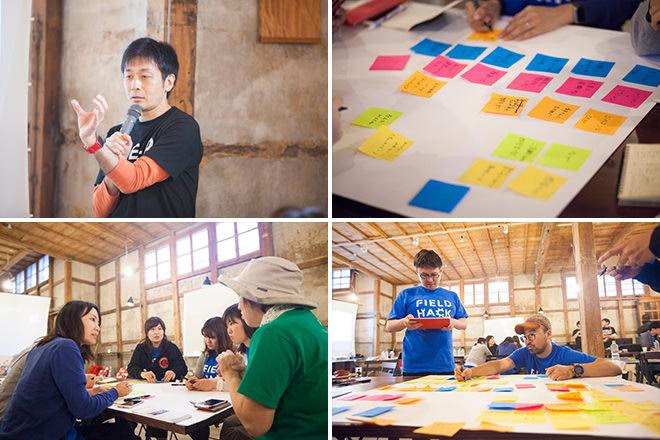
インプットした情報をその場に整理して並べていく参加者。記憶が新鮮なうちに行うのが大切です。
インプットした内容を付箋等にまとめ、言語化していくことで、フィールフドワークで知ったにいさん、ねえさんの想いに対して感じたこと、「感情」が生まれてきます。それが翌日のアイデア・コンセプトスケッチにつながるのです。
この時間では、より正確に感情を引き出すためにも、勝手に解釈したりせず、根掘り葉掘り聞いても良いんだよ!という雰囲気をつくりだすことがポイントです。
膨大な情報を短時間でインプットし、整理したあとは、懇親会が開かれました。
今回は、与謝野町が見渡せる公園でBBQを行い、与謝野町役場のみなさんが準備してくださったサプライズを楽しみながら、しっかり夜中まで行われました。ここまでくると、各チームとにいさん、ねえさん間で信頼感も生まれ、同じ方向を向いている関係性が築けてきました。
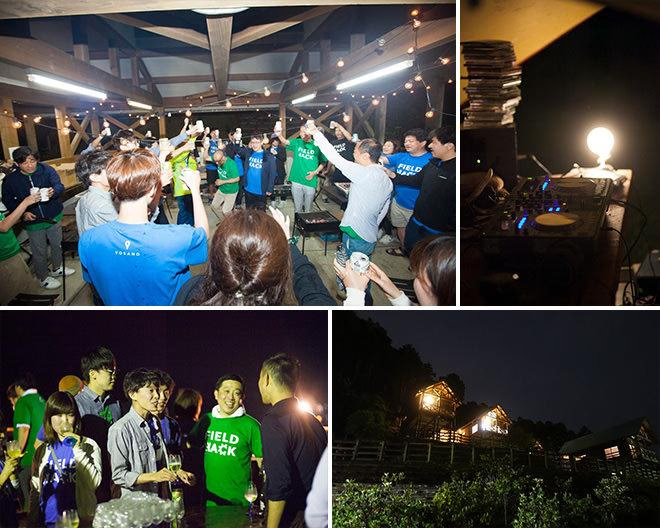
BBQを楽しんだあとは、特設バーでDJの心地よい音楽を聞きながら、参加者、主催者、運営者などの壁を超えて、全員が今回の出会いを楽しんでいるように見えました。
Day 2 : アイデア & コンセプトスケッチ (6/11)
各チームがインプットした内容を、プロトタイプのアイデアと、コンセプトに落とし込んでいく日です。前日のインプット整理の時間に引き続き、小林教授がファシリテーターとなって行われます。
その後、各チームがかかげたコンセプトは、にいさん、ねえさんに向けて発表し、プロトタイプの方向性「何を開発するか」のブラッシュアップを行います。

絵で表現するチームや、ダンボールを使って実際のプロトタイプのイメージをつくるなど、それぞれのチームによってコンセプトを表現していきます。ただ何か面白いものをつくるということではなく、フィールドワークで感じたにいさん、ねえさんの想いに対して、チームの特徴を活かして何ができるのか?をきちんと引き出すことが重要です。
実際ににいさん、ねえさんと濃密な時間を過ごした各チームからは、自然と想いを汲み取ったアイデアが次々と生まれていきました。

織物の織機(しょっき)と、その音に魅力を感じたチームはその臨場感を絵で表現。ヘルスツーリズムチームは、フィールドワークで出会った地域で密かに人気がある?狛犬をモチーフにしたプロトタイプイメージをダンボールで作成。
例えば、「ヘルスツーリズム」に挑んだ 2 チームは、来訪者が田舎に来ると感じれるほっこり感のみならず、健康になった!と感じて帰れるような、コンセプトを作成。舞台となる、与謝野町温江地区とチームの特徴、スキルを盛り込んだ発表を行いました。

例え同じテーマでも、そのチームならではの視点でプロトタイプのコンセプトが生まれます。
短期間で一気にコンセプトまでつくったため、ここまで来るとそれぞれのプロトタイプへの期待感に満ち溢れてきます。その後、発表したコンセプトの方向性をすり合わせ、実際に開発のスケジュールも決め、会は終了。チームは与謝野町を離れます。4 週間の開発期間の始まりです!

これからの期待感を持ちつつ、冷静にどう4週間を過ごすか議論を行います。一旦のお別れでは、与謝野町側のみなさんが一台一台駅に向かう車を見送ってくださいました(泣)
今回は、生まれたエネルギーを保つことをサポートするためにも、「中間報告」と題し、チームがにいさん、ねえさんに開発状況を共有、相談する場も設けました。イベント会期中にどれだけ一定のエネルギーを保ってもらえるかが鍵になるため、中間報告のように細かくマイルストーンを立てるサポートも重要になります。基本的にはビデオ会議で行われましたが、中には与謝野町に足を運んだチームもいました。
Day 3 : 発表会 (7/8 〜4 週間後〜)
発表タイム
4週間の開発期間を経て、各チームが与謝野町に集い、プロトタイプの発表とデモを行います。発表会は、関係者のみならず、一般に公開して行われました。

真夏を感じさせる熱気の中、発表会が始まります。ほぼ満席の会場。
発表会の開始です。与謝野にいさん、ねえさんの想いに対して、チームが出したアンサーとなる素敵な、そして感動を呼んだ 4 つのプロトタイプをご紹介します。
「発酵」 : チームオリザ
プロトタイプ名 : (考案中!)

オリザは、与謝野にいさん 与謝娘酒造 西原さんが想いとしてもつ、与謝野町産のお米と水を原料とした酒造りをしたり、「地域と一緒につくる酒」という部分に着目し、酒造りに関わる地域の資源を可視化することにとりくみました。

ユーザーが日本酒のラベルに貼られたQRコードから、与謝野町にズームインでき、原料は何で、どこからきているのか、酒づくりの過程をトレースすることができます。その情報はSNS等で共有できたりもします。また、作り手側からも「できた」その瞬間にボタンを押して発信することができ、双方をつなぐことができるプロトタイプです。

「ヘルスツーリズム」 : チーム Hmmi.e
男のヘルスツーリズム
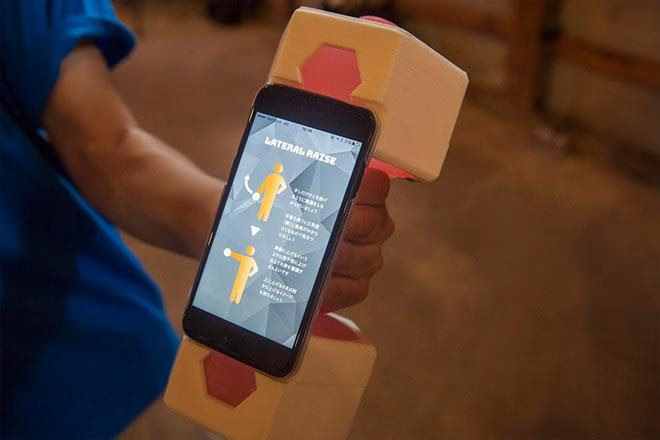
Hmmi.e は、男のヘルスツーリズムと題し、筋トレをしながら、与謝野町温江地区ならではの情報を知ることができたり、地域の人たちとの交流ができるプロトタイプを開発。健康 × 観光を男性チームという特色を活かして取り組みました。
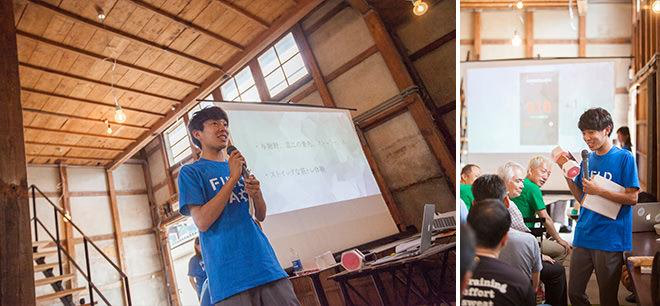
ウォーターダンベルに装着されたスマートフォンで、エクササイズの方法や回数、水分補強の指示などのお知らせをしてくれる基本的な機能に加え、「レスポ」と呼ばれる休憩地点にくると、音声ガイドでその場所について説明してくれたり、次のエクササイズの指示をだしてくれます。また、地域の人に出会うと、図鑑形式でその方の情報を表示してくれ、交流のきっかけをつくりだしてくれます。

「ヘルスツーリズム」 : チーム 乙女電芸部
多肉植物ブレスレット・狛犬ロボット

乙女電芸部は、温江の豊かな自然と美しい風景の中で、心と身体が健康になれる施設やプログラムの中で参加者の安全と健康を見守る「多肉植物ブレスレット」と「狛犬ロボット」を開発。移動中の楽しみや期待感、定量的な身体データの分析なども提供することで、定期的に通えるきっかけづくりを行いました。
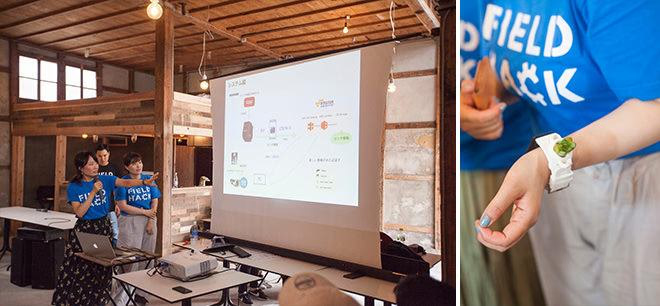
「多肉植物ブレスレット」では、心拍、歩数、GPS情報などをトラッキングできます。「狛犬ロボット」(温江地区では有名?!なぶさかわ狛犬)は、宿泊施設で待っており、最後に歩いたマップと癒され度がカルテとして口から出てくる仕組みになっていて、温江の昔話なども教えてくれます。

「織物」 : チーム 本郷テック
HATA no CODE
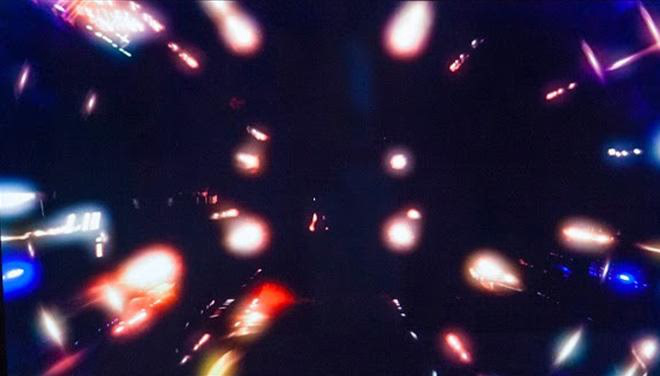
本郷テックは、与謝野町の伝統産業である織物の製品ではなく、その仕事やつくり手の魅力に着目。彼らが感じたその魅力を発信することで、織物に携わる人を増やしたいという想いを掲げ、織機(しょっき)の音と、織機が稼働している映像をメディアアート「HATA no CODE」(はたのこどう)と題した作品にして披露しました。

発表会では、室内の照明を落とし、にいさんから借りたごついスピーカーを使って彼らの作品を放映。かつては道を歩けばどこからでも聞こえたという、織機(しょっき)の音が、一つのアートとして生まれ変わりました。
(写真では全く伝わらないと思います!彼らが完成度を高め、どこかにアップした際には、ここにリンクを絶対はります!)
発表後のフィードバック & デモタイム
各チームの発表後には、にいさん、ねえさんと、テクニカルアドバイザーとして小林教授からもその場でフィードバックがもらえます。



どちらかが受けた仕事という形ではなく、想いを共有して共につくった参加者とにいさん、ねえさん。そんなプロトタイプに感動の場面もありました。
そして会は、デモの時間に進みます。一般来場者が、発表で聞いた内容を実際に見て、手で触れてみることで、それぞれのプロトタイプの可能性を実感していただきます。
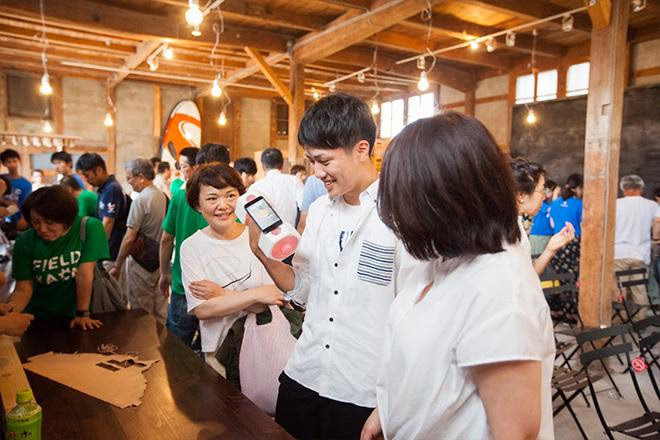

もちろん、発表会最後は、参加者、関係者で打ち上げを行います。
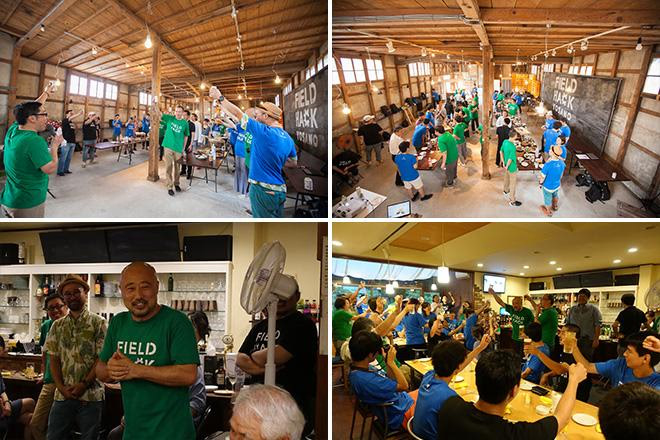
この日は発表直前までプロトタイプの調整や、発表資料を修正したり、そもそも徹夜で参加している方もいたり、それぞれがやりきった感、そして安堵の表情が伺えました。Day 1 時に比べると落ち着いて与謝野町のみなさんとの怒涛の1ヶ月を振り返りながら最後の夜を楽しんでいるように見えました。
発表会の主役は参加チーム。それぞれが、発表やデモをしやすいよう、そしてできる限り多くの方に見てもらい、フィードバックが聞けるよう、少しでも多くのサポートを行うことが大切です。今回は、与謝野町のみなさんが一丸となって協力してくださったため、良い状態で終えることができました(と思ってます!)。
Day 4 : 相談会 (7/9)
Field Hack 最後のプログラムは、さらなる開発とプロトタイプ実装に向け、次の計画をにいさん・ねえさんや地域コーディネーターさんなど地域の方々とディスカッションする相談会です。それぞれがとても忙しいので、きめ細く長く続けていくことがとても難しい中、プロトタイプをどう次のステップに進めていくか、次の目標と、費用やスケジュール感までどこまで具体的に議論ができるかがポイントの日です。

今回は、にいさん、ねえさんとコーディネーターさん以外にも役場の方や、専門家にも同席いただけたため、より多角的な議論が進み、実装に向けた拍車がかかりました。
長々と記載しましたが、各プログラムの雰囲気はアツく、Field Hack はエネルギーの高いイベントです。このイベントがつくりだすエネルギーはどこからくるのでしょうか?
そもそもエネルギーって...と思いますが、きっと、これまでに出会ったことのない人と人が、一つの可能性に向かって一緒になって取り組むことで生まれるのではと思いました。
今回の場合だと、それぞれの分野ではプロフェッショナルである与謝野にいさん、ねえさんとテクノロジーを駆使する参加チームが、想いを共有し、そこに対して自分ができることを考え、ものをつくる。普段は関わることのない 2 者が、Field Hack という場をとおして出会い、ひとつの可能性を発見してそれに向かって一緒に取り組むことで、とてつもないエネルギーを生み出すのだろうと感じます。
ただ、これはイベントだからこそ瞬間的に完成できるものでもあると思います。Field Hack は、あくまでの、最初の一歩を短期間で踏み出すイベントです。そこで生まれたこのエネルギーをどこまで継続させることができるか? これが主催者の次のミッションだと思います(乞うご期待!)。
最後に、この場をかりて、与謝野町のみなさん、参加者のみなさん、そしてご協力いただいた各組織のみなさん、本当にありがとうございました。
ハッカソンと一言では語れない、感情や、人の想いが込もったイベントになったと思います。
Field Hack 、たまりません。
